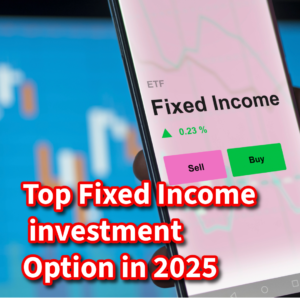
In a rapidly changing financial landscape, it’s essential to stay updated on the best fixed-income investment options. These instruments provide stability, steady returns, and peace of mind, making them a favorite among risk-averse investors. This guide explores the top fixed-income choices in India for 2025, highlighting their benefits, risks, and suitability for different financial goals.
- Fixed Deposits (FDs): Fixed Deposits are a go-to option for many Indian investors due to their simplicity and guaranteed returns.
– Interest Rates:Typically range between 6-8% per annum, varying by bank and tenure.
– Tenure:Flexible options from 7 days to 10 years.
– Tax Benefits: FDs under the 5-year tax-saving category are eligible for deductions under Section 80C.
Example:
If you invest ₹1 lakh in a 1-year FD at 7%, you’ll earn ₹7,000 in interest, which is entirely predictable.
- Public Provident Fund (PPF) : PPF is a government-backed scheme offering long-term savings and tax benefits.
– Interest Rate: Around 7.1% (subject to quarterly revisions by the government).
– Tenure: 15 years, with partial withdrawal options after 7 years.
– Tax Benefits:Investments, interest, and maturity proceeds are tax-exempt under Section 80C.
Who Should Invest: Ideal for long-term goals like retirement or child education.
- Corporate Bonds: Corporate bonds allow you to invest in companies by lending them money in exchange for periodic interest payments.
– Interest Rates: Higher than FDs, typically 7-10%, depending on the issuer’s credit rating.
– Risks: Credit risk exists, so always check the bond’s rating (e.g., AAA for high safety).
Example:
A AAA-rated corporate bond from a leading company offers an 8% return, which is higher than a bank FD but comes with slightly higher risk.
- Government Securities (G-Secs) : G-Secs are bonds issued by the Indian government, offering the highest level of security.
– Interest Rates: Around 6-7%.
– Tenure: Ranges from short-term (1 year) to long-term (up to 40 years).
– Liquidity: Can be traded in the secondary market.
Who Should Invest: Best for ultra-conservative investors and retirees.
- RBI Floating Rate Savings Bonds: These bonds provide protection against fluctuating interest rates.
– Interest Rates:Adjusted every 6 months based on prevailing rates (currently 8.05%).
– Tenure: 7 years.
Example:
If interest rates rise, your returns also increase, ensuring you stay ahead of inflation.
- Non-Convertible Debentures (NCDs) : NCDs are issued by companies to raise capital and offer fixed returns over time.
– Interest Rates: Typically 8-11%.
– Risks: Higher returns come with credit risks.
Who Should Invest: Suitable for investors comfortable with moderate risk for better returns.
- Fixed-Income Mutual Funds: These funds invest in various fixed-income securities like bonds, G-Secs, and money market instruments.
– Types: Debt funds, gilt funds, liquid funds, etc.
– Returns: Vary based on the fund type and market conditions (typically 5-10%).
– Tax Efficiency: Long-term capital gains (over 3 years) are taxed at 20% with indexation benefits.
Who Should Invest:Ideal for those seeking professional management and diversification.
- Post Office Monthly Income Scheme (POMIS): A small savings scheme offering guaranteed monthly income.
– Interest Rate: Around 7.4%.
– Tenure: 5 years.
– Max Investment: ₹9 lakh (joint account) or ₹4.5 lakh (individual account).
Example:
Invest ₹4.5 lakh, and you’ll receive approximately ₹2,775 monthly as interest.
- Treasury Bills (T-Bills): Short-term debt instruments issued by the government.
– Tenure: 91 days, 182 days, and 364 days.
– Returns:Competitive and risk-free, though lower than long-term bonds.
Who Should Invest: Suitable for parking surplus funds for short periods.
- MLD (Market Linked Debentures) : Which Give Safety net + Market Benefit Exposure various option available based on Time Period and Risk Appetite
Conclusion
Fixed-income investments are a cornerstone of financial stability and offer something for everyone—from ultra-safe government bonds to higher-yield corporate bonds. By understanding the features and risks of each option, you can align your investments with your goals and risk tolerance.
For 2025, the above options cater to diverse needs, ensuring you can build a balanced portfolio with steady returns and peace of mind.
To Know more You can Reach out to us on :- 9560314594
Our Financial Planner help you to choose best fixed income investment option.